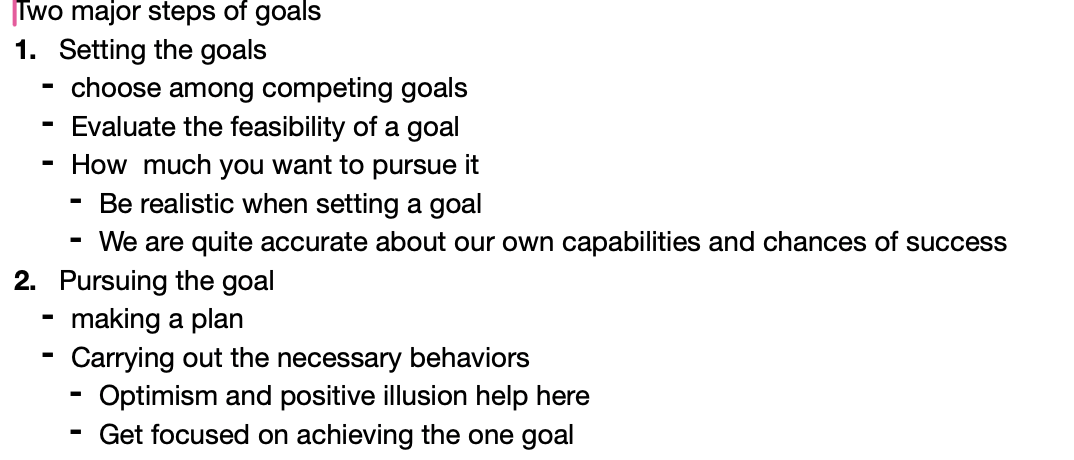Social Psychology exam 2
1/58
There's no tags or description
Looks like no tags are added yet.
Name | Mastery | Learn | Test | Matching | Spaced |
|---|
No study sessions yet.
59 Terms
self-handicapping
putting obstacles in the way of ones performance so that anticipated or possible failures can be blamed on the obstacle and not lack of ability
learned helplessness
ones actions will not bring about desired outcomes, leading to giving up and quit trying
planning fallacy
planners are overly optimistic because planners fail to account for unexpected problems
distal goals
long-term, final end goal
proximal goals
short term, stepping stones to long term goals
goal shielding
when working towards one goal you shut out others from consciousness
behvaiorism
explains behaviors based on learning disregarding inner states, thoughts or feelings
risk averision
more affected by possible losses than possible gains
panic button effect
having the belief that one has the option of escaping or controlling the situation reduces stress of suffering
error management theory
minimize consequences of error
self-defeating behavior
any action which people bring failure, suffering, or misfortune on themselves
certainty effect
greater weight given to definite outcomes than probabilities
temporal discounting
what happens now weighs more than what might happen in the future
reactance theory
people become distressed by loss of freedom or options and seek to reclaim or reassert them
setting and pursuing goals

self-determination theory
people neeed at least some degree of autonomy and internal motivation
the zeigarnik effect
tendency to remember unfinished or interrupted tasks better than completed ones
status quo
keep things the way they are instead of change. Effort, scared of change
omission bias
take the course of action that does not require you to do anything (default option) Prefer, its working why change
self-regulation
capacity to alter one’s own reponses
TOTE
test, operate, test, exit, used to achieve goals
goals
some desired future state
capacity for change
actually carrying out the changes
when do attitudes predict behavior
Specificity (attitude closely relates to behavior) and Aggregation (general attitudes predict aggregates of behavior)
cognitive dissonance theory
inconsistencies produce psychological discomfort
balance theory
can be combination of any 3 things. when axbxc= positive value
how attitudes are formed
learned through experience
implicit attitude
Measures of attitufe that are physiological, physical movements, or IAT/AMP
explicit attitude
assume people are aware of their attitudes, able to report them, and willing to report them
zanna & cooper - disonance and arousal
cognitive dissonance creates a state of physiological arousal, and people are motivated to reduce this discomfort by changing their attitudes
functions of attitudes
utilitarian, ego-defensive, social adjustive, value-expressive
mere exposure
tendency to like things simply because you encounter them repeatedly
attitudes
an evaluation reaction to an attitude object (person, thing, issue) that is exhibited in feelings or intended behavior
beliefs
Facts or opinions
strong attitudes
persist over time, resist attempts at counter-persuasion, guide future thoughts and behaviors
the lapiere - chinese couple
In a classic study, LaPierre (1934) drove through the U.S. with a
Chinese couple. They stopped at over 250 restaurants and hotels and
were refused service only once. Several months later, the owners were
surveyed on whether they would serve Chinese people. The response
was overwhelmingly negative, 92 percent of those surveyed said that
they would not
In this case, their behaviors gave less evidence of racial bias than their expressed attitudes did
Problems with this:
Different time… six months later
Different people
Chinese couple spoke flawless English; accompanied by standoff professor
nevertheless, subsequent research did show that in some cases attitudes did not predict behaviors
classical conditioing
learning in which, through repeated pairings, a neutral stimulus evokes a conditioned response
social learning
imitate behaviors that are rewarded, less likely to imitate behaviors that were punished for
post-decision spread
people downplay close alternatives after difficult choice
effort justification
when people work hard or sacrifice, they try to convince themselves it is worthwhile
evolutionary presecptive on mating
attitudes behaviors shaped by natural selection and tend tone innate, goal for survival and passing on genes
short term mating
males more likely to report they would enter short term, male reproduce widely females do it wisely
long term mating
females more likely
attraction
initial attraction, best predictor for liking and desire to contiue dating
gotmans four horsemen
criticsm, defensiveness, contempt, withdraw. positive interactions must outweigh negatives 5:1
importance of physical attraction
Most important predictor for liking and desire to continue dating after
opposites and attraction
SImilarity/complementary is what is sought after. we like whose who believe what we believe
reinforcement theory
behaviors are shaped by consequences such as rewards and punishments
social acceptance
one has to gain this, changing or adapting to others to appeal to them
the commitment model
commitment, satisfaction, dependence/alternatives, investments
men and womens acceptance of offers of sex
men more likely than women
matching hypothesis
we seek those who are similar to ourselves in social desirability and physical attractiveness
what is beautiful is good effect
we assume physical attractive people are superior to others
propinquity effect
physical or psychological proximity between people
strategies for relationship maintenance
four horsemen
utilitarian,
serves some useful function, like should i approach them>
ego-defensive
feel better about ourselves
social adjustive
helps us id with admired others
value-expressive
internal expression of some values we have